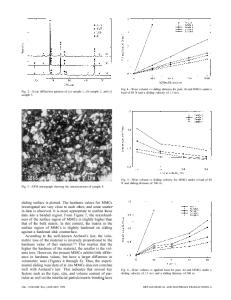Role of Al 2 O 3 particulate reinforcements on precipitation in 2014 Al-matrix composites
- PDF / 2,915,006 Bytes
- 12 Pages / 598 x 778 pts Page_size
- 25 Downloads / 306 Views
I.
INTRODUCTION
A G I N G characteristics of discontinuously reinforced metal-matrix composites (MMCs) with precipitationhardenable matrices have been widely reported to be accelerated relative to the unreinforced matrix alloy. 11-91This behavior generally has been attributed to enhanced nucleation and growth due to the presence of high matrix dislocation densities around reinforcements. Matrix dislocations have been found to reduce the incubation time for heterogeneous nucleation of the strengthening precipitates, t6,81 as well as to increase solute diffusivity in the composite matrix, tS'~~ Additionally, the elastic strain fields induced in the matrix because of the presence of reinforcements may promote stress-assisted solute diffusion, thereby accelerating precipitation in the composites with relatively low matrix dislocation density and/ or large particle size.[Sl Calorimetric studies on a number of MMC systems have shown that the addition of SiC to aluminum alloys does not alter the precipitation sequence of the matrix alloy, although precipitation kinetics are generally accelerated, tvl In addition to altering the kinetics, reinforcement addition has been observed to (a) alter the relative amounts of the precipitates formed;tSl (b) make some normally quench-insensitive materials quench-sensitive;[Tj and (c) significantly alter the level of peak hardening Obtained in the composite matrix relative to the unreinforced alloy.H,3,8.~.~z~While most studies indicate that the composite matrix hardens to a higher level than the unreinforced matrix, at least one instance of the composite matrix having a lower peak hardness has been reported, till This was attributed to a decreased vacancy concentration in the MMC matrix. I. DUTrA, Associate Professor, and G. DUTrA, Adjunct Research Professor, are with the Department of Mechanical Engineering, Naval Postgraduate School, Monterey, CA 93943. C.P. HARPER, formerly Graduate Student, Department of Mechanical Engineering, Naval Postgraduate School, is currently with the United States Navy. Manuscript submitted May 24, 1993. METALLURGICAL AND MATERIALS TRANSACTIONS A
Much of the literature on aging of composite matrices is based on powder metallurgy (PM) processed materials, t~'5-7,~~ Although precipitation in cast alloys is slower than in PM processed materials, 171cast SiC-A1 composites have also been shown to exhibit accelerated aging. 19'~2] A recent study of alumina-particulate-reinforced cast 6061 A1 composites revealed accelerated aging relative to the monolith, t8j although the difference in the coefficient of thermal expansion between alumina and A1 (-15 x 10-6/K) is smaller than that between SiC and A1 (~10 • 10-6/K). So far, only one investigation of the aging behavior of 2014 AI in the presence of reinforcements (SIC) has been reported, t9~ It found that reinforcements enhance the overall aging kinetics in 2014 A1 at 195 ~ but had little effect at 150 ~ The impact of reinforcements on each of the precipitation processes, however, was not studied in detail. To d
Data Loading...











